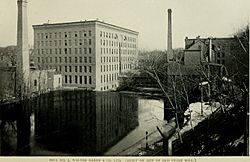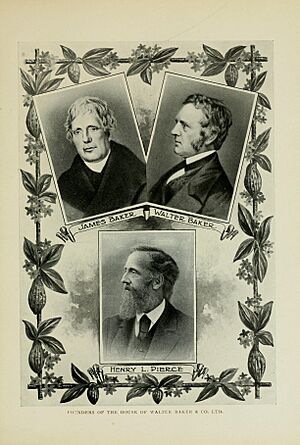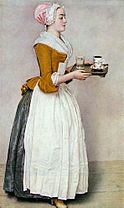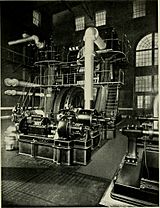- This page was last modified on 1 January 2026, at 00:04. Suggest an edit.
Walter Baker & Company facts for kids
This page is about the former company. For the chocolate brand by Kraft Heinz, see Baker's Chocolate.

Baker chocolate factory in 1907
|
|
| Limited | |
| Industry | Food |
| Fate | Merged into Kraft Foods in 1995 |
| Successor | Kraft Heinz |
| Founded | 1780 |
| Founder | James Baker |
| Defunct | 1995 |
| Headquarters |
,
U.S.
|
| Products | Chocolate |
| Brands | Baker's Chocolate |
| Owner |
|
The Baker Chocolate Company was a famous American company that made chocolate. It was located in Dorchester, a part of Boston, Massachusetts. This company was actually the first to make chocolate in the United States!
After its first owners passed away, the company was sold to the Forbes family in 1896. They ran the business for many years. Later, in 1927, it was sold to Postum Cereal, which became General Foods. Today, the Baker's Chocolate brand is owned by Kraft Heinz, after being bought by Kraft Foods in 1995.
Contents
The Start of Baker Chocolate
The Baker Chocolate Company began thanks to a doctor named James Baker. He met a skilled chocolate maker named John Hannon near the Neponset River. John Hannon had learned how to make chocolate in England. This skill was very rare in America at the time.
With Dr. Baker's help, Hannon started a business. He made "Hannon's Best Chocolate" for 15 years. In 1779, Hannon traveled to the West Indies and never came back. His wife then sold the business to Dr. Baker in 1780. Dr. Baker renamed it the Baker Chocolate Company.
Growing the Chocolate Business
Dr. James Baker's son, Edmund, and his grandson, Colonel Walter, continued the family business. They worked hard to make it successful. They even promised customers their money back if they weren't completely happy with the chocolate.
Colonel Walter Baker studied law at Harvard College. He made sure the "Baker's" name was legally protected. This helped the family business for many years to come.
After Colonel Walter Baker died, his brother-in-law, Sidney Williams, took over. But Sidney also passed away just two years later. Then, Henry Lillie Pierce, who was Walter Baker's step-nephew, took charge of the company for 30 years.
Henry Pierce Expands the Company
Henry Lillie Pierce helped the Baker Chocolate Company grow a lot. He added more buildings to make chocolate. He also found new places to sell their products. He showed Baker's chocolate at big exhibitions around the world. He even won an award at the Vienna Exhibition in 1873.
Henry Lillie Pierce was also an important person in Dorchester. He was elected mayor of Boston twice. He also served as a US congressman and in the Massachusetts House of Representatives.
The Famous Chocolate Girl Logo
(Left): Das Schokoladenmädchen by Jean-Étienne Liotard, 1743-45, inspired the logo of the company, "La Belle Chocolatière"; (right): Interior of the Baker factory in 1907
The famous Baker Chocolate logo is called "La Belle Chocolatière." This means "The Beautiful Chocolate Girl" in French. The logo was inspired by a painting by a Swiss artist named Jean-Étienne Liotard. The painting is called Das Schokoladenmädchen (The Chocolate Girl). You can see the original painting in an art gallery in Dresden, Germany.
The painting was made in the 1740s in Vienna, Austria. Liotard was painting portraits for the Austrian Empress Maria Theresia. The story goes that the model for the painting was a young lady at the court. Her beauty inspired Liotard to paint her.
In 1913, Walter Baker & Company shared a story about the girl in the painting. Her name was Anna Baltauf. She was the daughter of a knight in Vienna. It's not clear if she worked as a chocolate server or just posed in the costume. But her beauty caught the eye of a prince named Dietrichstein. They fell in love and got married. This marriage caused a lot of talk in Vienna because people from different social backgrounds usually didn't marry. Anna was probably around 20 years old when the painting was made in 1760. She lived until 1825.
Changes in Ownership
After Henry Pierce died in 1896, the company was sold to the Forbes Syndicate. They made the factory much bigger. They added several new buildings for making and storing chocolate. The Forbes Syndicate also advertised Baker's chocolate in popular magazines like Youth Companion and Red Book Magazine.
The Forbes Syndicate had a clever idea to keep customers loyal. They gave out coupons that could be traded for special items. These included bone china dishes, bookends, spoons, and serving trays. They also published a very popular cookbook every year.
In 1927, the Postum Cereal Company bought Walter Baker & Company. Two years later, Postum became General Foods. In 1965, they moved the chocolate production to Delaware. By 1995, Walter Baker & Company became part of Kraft Foods. Today, it is part of Kraft Heinz. The old factory buildings in Dorchester are now part of a historic industrial area.



